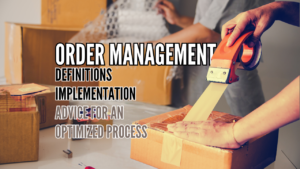
Starting an e-commerce venture is currently an ideal pursuit for any aspiring entrepreneur. In 2024 e-commerce continues to thrive, with consumers increasingly turning to online purchases. While the skills in e-commerce marketing and business management gained from this experience aren’t typically taught in textbooks, some aspects can be anticipated to prevent making mistakes.
Indeed, learning occurs through practice, yet it’s crucial to prepare your online business thoroughly, foresee potential challenges, and grasp the best advice that has propelled e-commerce stores and related business models to success.
To assist you in building your brand, we’re sharing all the essential information needed to expand your e-commerce website.
What is e-commerce?
E-commerce (or ecommerce) is a commercial practice aimed at connecting merchants and buyers on the Internet for the purpose of a transaction, whether it involves purchasing a product or a service.
Transactions of goods and/or services take place through an online store, a mobile application, and other sales channels such as social networks, price comparison websites, marketplaces, affiliate platforms, retargeting platforms, and more.
What are the economic models of online commerce?
When you decide to sell your products or services online, you have the option to target either individual consumers (BtoC) or businesses (BtoB). Business-to-Consumers (BtoC) e-commerce is the most prevalent form of e-commerce worldwide. Business-to-Business (BtoB) e-commerce, on the other hand, is a practice that is gaining momentum, offering new revenue sources for merchants aiming to elevate their businesses.
E-commerce encompasses the sale of both products and services, applying to online stores owned by brands or companies as well as marketplaces like Etsy or Fnac.
Furthermore, being a distinct economic sector, e-commerce is regulated by law and subject to legal regulations. Therefore, there are mandatory disclosures required on your e-commerce site to inform consumers about the ordering process, delivery times, product return policies, and customer data protection.
What are the advantages of e-commerce?
Whether you’re about to launch your business or aiming to enhance your online presence, ecommerce offers numerous advantages:
- The ability to reach a broad audience.
- Detailed insight into your customers’ purchasing behavior through various online marketing tools and data analytics.
- Implementation of targeted marketing actions to provide a quality and unique shopping experience for online buyers.
- Unlike a physical store, your e-commerce site operates continuously, preventing missed sales opportunities.
How does e-commerce work?
E-commerce enables buyers to find their desired goods or services online. While browsing the Internet, some buyers know exactly what they’re looking for by visiting search engines like Google or marketplaces, while others seek inspiration and prefer social platforms such as Instagram or Pinterest. Once the buyer finds what they seek, they can place an order, which will then be shipped and delivered to their home or a pickup point.
Online sales occur through an e-commerce site connected to secure payment systems and banking facilities. Despite the widespread nature of e-commerce purchases today, there remains a lingering skepticism about potential payment security loopholes or scams.
How to conduct online commerce?
While it’s possible to sell products directly through a marketplace or certain social networks, it’s strongly advisable to set up your online store using an e-commerce platform like Shopify. By creating your own e-commerce store, you’ll have better control over your business and can build a distinct brand identity.
Recommended Reading: How to protect your brand, defend it and monitor it?
1. Performing Financial Calculations
When launching your venture, paying close attention to financial calculations is crucial for achieving profitability.
To gauge your e-commerce’s profitability potential, you can utilize this formula: Profit = Demand x (Revenue – Expenses).
Consider this example: 20,000 individuals are searching for your product (assuming a high search volume for the primary keyword and long-tail keywords).
If you can reach half of them, your target audience will consist of 10,000 potential buyers. With a conversion rate ranging between 1% and 2%, you could generate 100 to 200 sales.
Assuming your average order value is $100 and your profit margin is 30%, your potential profit would range between $3,000 and $6,000.
These figures are approximations, but taking the time to forecast and perform financial calculations will enable informed decisions before setting up your online store in your chosen niche.
2. Analyzing Your Market
To prevent your online store from going unnoticed, it’s crucial to differentiate yourself from the competition. Take the time to conduct competitive analysis and market research to gain better insights into your competitors’ activities.
There are numerous differentiation factors, as remember, you are unique. Consider what makes you unique: the quality of your products, their production method, attractive pricing, your values, brand story, etc.
Set yourself apart not only with your products but also through your content: testimonials, social media posts, blog articles, media appearances, etc.
Additionally, with some search engine optimization (SEO) efforts, you can increase your organic traffic.
Recommended Reading: What is local SEO and how does it work?
3. Building Your Brand Identity
Building a strong brand identity is crucial since your company’s value largely depends on your brand. When starting, ensure coherence between the goods/services you sell. Otherwise, this strategy may complicate targeting your clientele and negatively impact keyword search efforts.
Building your brand identity involves several steps: brand name selection and defining your values. Your brand’s image stems from these values and the identity that defines you, also known as your brand’s DNA. Choosing colors, creating a logo, designing communication materials, and your visual identity should align with this uniqueness that makes your brand recognizable among others.
4. Establishing a Content Strategy
It’s a common mistake. Many brands don’t invest enough in content marketing, hindering their ability to generate organic traffic from search engines and social networks.
Depending on your niche, content creation may vary in difficulty. To assist, focus content marketing on your customers rather than your products. By constructing a customer-focused content marketing strategy instead of just promoting your products, you can cover numerous topics and engage authentically with your audience.
Even if you’re in a technical niche and manage to write 50 or 100 articles mainly about your product’s features, these resources alone might not suffice. To complement your efforts effectively, establish relationships with your customers beyond mere transactions.
5. Offering Free Products or Samples
Some entrepreneurs rapidly boost their e-commerce stores by offering free products. Gifts, contests, and promotions are excellent ways to market a product, but they don’t consistently work across all niches.
Free samples might be effective if you sell perishable or consumable products: beauty, food, etc.
However, for other product types, even those that could be repeatedly purchased, like clothing, you may not reap the rewards of this investment.
If these promotional tactics don’t stimulate sales, they’re part of a brand-building strategy. To build a strong e-commerce brand, you need a plan.
6. Hosting a Contest Online
Contests are a great way to promote your online store, increase your social media following, and grow your email list. For instance, organizing a contest with a blogger to win a $100 gift card.
To stir up excitement on social media, engage fans from the start and establish a plan to cultivate a lasting relationship with this community. Find content to share daily. Regularly share your own content. Initiate conversations. Assist people. Establishing an effective presence on Facebook and Twitter requires significant effort.
If you plan an online contest, ensure you conduct related financial calculations beforehand. These financial projections could prove more beneficial than the contest itself.
7. Focusing on the Essentials
In economics, there’s the concept of opportunity cost. Essentially, by choosing to pursue a particular opportunity, you forfeit the chance to consider others. Therefore, the cost of an opportunity is giving up all other available opportunities.
If you opt for the bootstrapping approach to launch your business, chances are you’ll have to do everything yourself. This means setting up the website, customizing it, uploading your products, writing all descriptions, and executing all marketing.
The challenge here is that although doing everything yourself can be rewarding, it typically consumes a lot of time. This time could be utilized differently, brainstorming new ideas, expanding your professional network, etc.
Subordinate tasks can be categorized into two types: necessary and unnecessary. You should try to automate necessary secondary tasks as much as possible. While this process may require some financial investment, it’ll save you considerable hassle. Moreover, finding freelancers willing to perform administrative or repetitive tasks (adding new products, data entry, etc.) is very feasible.
Unnecessary tasks, on the other hand, should be set aside. Examples include spending excessive time designing your site’s logo, making minor aesthetic adjustments to photos, trying to optimize the color of a button, or any other minor change that you’ll likely be the only one to notice.
Even if some of the mentioned examples could positively impact your conversions if you were to focus on them, you can assess your efforts and results only when you have enough data to compare your sales and traffic over time. Therefore, when launching your online store, it’s best to avoid dwelling on these tasks. By doing these actions, you might feel like you’re working productively, but in reality, your time could be more efficiently spent.
8. Knowing Your Target Customers
Studying your niche market boils down to two objectives: finding a product and defining your target customers (building avatars or “buyer personas”). While it’s possible to build an audience and then create a product, having a product and then finding customers is very challenging.
It’s generally recommended to rely on analytical data when evaluating a niche, which is absolutely necessary.
However, even if there’s ample demand in your niche market and a wide selection of products to sell, if you can’t define your target customer, the task will be much more challenging. Through in-depth analysis, you’ll realize there are sub-niches within every niche market. The more targeted your approach, the better, as you’ll more easily understand your customers’ needs.
9. Creating a Strong Marketing
When setting up your e-commerce business and understanding who your customers are and where to find them, establishing an effective e-commerce marketing plan becomes straightforward.
While you’ll need a well-thought-out marketing plan for each e-commerce project you plan to launch, understand that some channels will be more effective than others. Some e-commerce sites might benefit more from pay-per-click (PPC) advertising, while others may see better success with search engine optimization (SEO) or social media marketing. However, email marketing can be considered a stable channel.
Whatever your plan is, ensure you can implement it as soon as you start your online selling activity. New opportunities will naturally arise, but if your core strategies are robust, you can experience sustained growth and manage large-scale development.
10. Choosing an Agency that Meets Your Needs
During the launch of your online business, you might consider engaging an agency to enhance your brand’s visibility. When doing so, ensure that the agency’s offering aligns with the niche you’ve selected.
Here are two remuneration models practiced by agencies:
- a) Charging a fixed sum for advertising expenses.
- b) Setting a budget for advertising (above a fixed minimum). In this case, you pay the agency a defined percentage of the advertising budget.
With option
a), your small business will allocate a significant budget to pay for the service without a guaranteed return on investment, while with option b), you need a substantial starting budget.
Many businesses find significant success with PPC; you simply need to understand your requirements.
Our Recommendations for Entrepreneurs Looking to Launch an Online Store
With all these pieces of advice we’ve presented, you might wonder: How do I know if I’m on the right track? No one can predict your future, but to assist you to some extent, here’s a list of 10 key steps for engaging in e-commerce and launching your online store:
- Choose the product you want to sell.
- Analyze your market: demand, competition, and conduct preferably a niche market study.
- Define your persona: the profile of your ideal customer.
- Define your business model: how will you make your business profitable and achieve your remuneration goals?
- Select your trusted supplier(s) for your products.
- Create your brand identity: brand name, visual identity including logo and graphic design, editorial identity with your storytelling and wording.
- Build your online store: choose a robust e-commerce platform like Shopify, select a theme to personalize according to your brand identity.
- Integrate products, install applications to enhance the customer experience, work on your SEO with relevant keywords.
- Create your social media strategy and accounts tailored to your sector and targets. For instance, Instagram is ideal for the fashion sector. Don’t forget to integrate your online store via Facebook.
- Boost the visibility of your e-commerce business through Google Ads campaigns, press articles, or partnerships with influencers.





